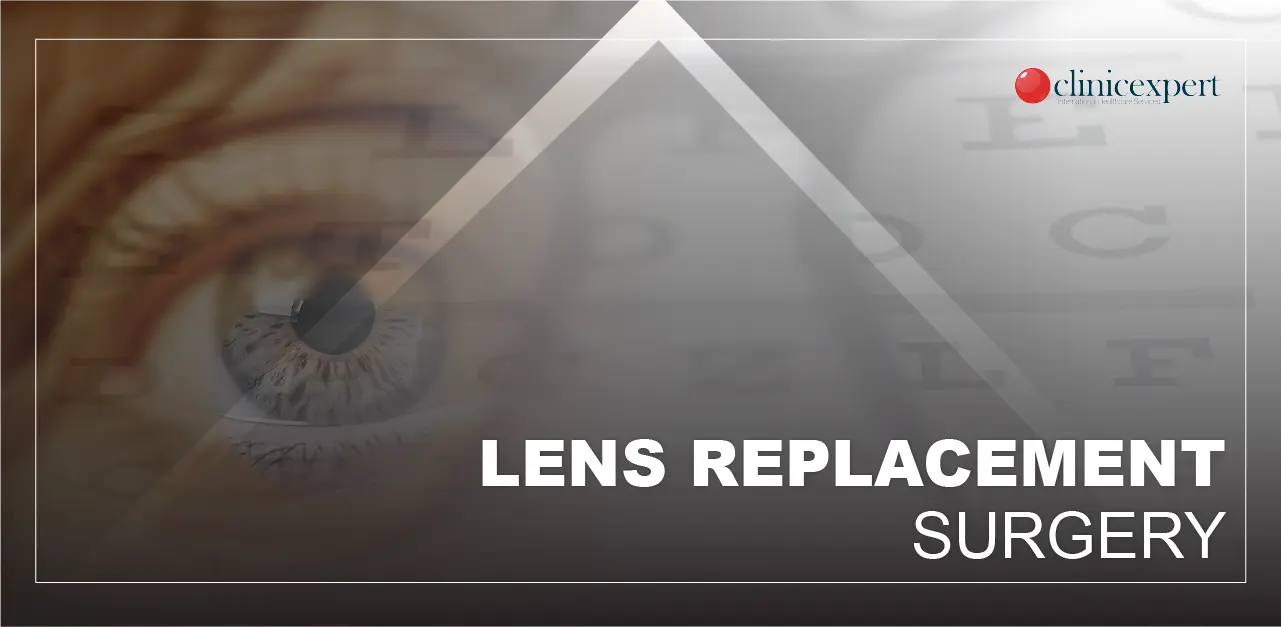Refractive Lens Exchange
Lens replacement surgery is considered a breakthrough solution for vision correction. What we can treat with this operation is not only cataract or presbyopia. It is also possible to address a range of eye conditions; up to high levels of myopia or hyperopia, with lens replacement. This explains why this operation is becoming increasingly popular.
However, as with any medical procedure, there are things to be aware of before opting for one of the lens replacement surgeries. Weighing its benefits against its potential disadvantages is crucial.
What is Eye Lens Replacement?
Eye lens replacement surgery, also known as refractive lens exchange (RLE), involves the removal of the eye’s natural lens and its substitution with an artificial intraocular lens (IOL). This procedure is similar to cataract surgery, but primarily aims at correcting refractive errors to reduce dependence on prescription glasses or contact lenses. It’s an elective procedure for individuals who might not be suitable candidates for laser vision correction surgeries like LASIK.
Types of IOLs
There are several types of IOLs used in lens replacement surgery, including monofocal, multifocal, and toric lenses, each designed to address different vision needs. Monofocal IOLs correct vision at one distance, requiring patients to use glasses for near tasks. Multifocal IOLs provide a range of vision, potentially eliminating the need for glasses. Toric IOLs correct astigmatism alongside nearsightedness or farsightedness.
What are the Pros and Cons of Lens Replacement Surgery?
What are the Benefits of Lens Replacement Surgery?
1. Broad Range of Vision Correction: Lens replacement surgery can correct a wide range of refractive errors, including presbyopia, making it suitable for individuals who are not candidates for LASIK or PRK due to thin corneas or high refractive errors.
2. Permanent Solution: Unlike temporary solutions like glasses or contact lenses, lens replacement offers a permanent correction for vision errors, with IOLs designed to last a lifetime.
3. Quick Recovery: Most patients report significant improvements in vision within a day or two after surgery, as well as with minimal downtime.
4. Prevents Cataracts: By replacing the eye’s natural lens, the procedure also eliminates the possibility of developing cataracts in the future, offering a two-fold benefit.
What are the Downsides of Lens Replacement Surgery?
1. Risk of Complications: Just like any surgery, there are risks involved, including infection, bleeding, and retinal detachment. While rare, these complications can have serious consequences.
2. Adaptation Period: Some patients may experience difficulties adjusting to multifocal or toric IOLs, reporting symptoms such as glare, halos, or blurred vision at certain distances during the initial adaptation period.
3. Cost: Lens replacement surgery can be expensive. The costs varying widely depending on the type of IOL chosen and the facility. It’s also worth noting that most insurance plans do not cover the cost of elective lens replacement surgery.
4. Not Reversible: Unlike some other vision correction procedures, lens replacement surgery is permanent. If complications arise or if the outcome doesn’t meet the patient’s expectations, adjusting the results can be challenging.
Consult with a Specialist
Deciding whether to undergo lens replacement surgery involves careful consideration of the potential benefits and risks. Here are a few steps to help make an informed choice:
Consultation with a Specialist: A comprehensive eye exam and consultation with an ophthalmologist specializing in lens replacement surgery are essential. The specialist can evaluate your eye health, discuss suitable IOL options, and outline realistic expectations based on your vision needs and lifestyle.
Consider Your Vision Goals: Reflect on what you hope to achieve with the surgery. Are you looking to be glasses-free, or are you seeking to correct a specific vision problem? Your goals will significantly influence the type of IOL and the surgical approach.
Weigh the Risks and Benefits: Assess the potential improvements in quality of life against the risks and costs involved. It’s crucial to have a clear understanding of the possible side effects and complications, as well as their management.
Post-Surgery Adjustments: Be prepared for a period of adjustment following the surgery. Depending on the type of IOL, it may take some time to adapt to your new vision. Discuss with your doctor what to expect and how to manage any temporary discomfort or visual disturbances.
Financial Planning: Given the significant cost of lens replacement surgery, consider your financial options carefully. Some clinics offer financing plans, which can make the procedure more accessible.
Final Thoughts on Lens Replacement Surgery
Lens replacement surgery presents a compelling option for those in pursuit of a lasting resolution to their vision impairments. The advantages it offers are significant; however, it’s critical to carefully consider the potential drawbacks and risks involved. Consequently, engaging in comprehensive research and seeking the counsel of experienced professionals are crucial steps in determining if this surgical approach is in harmony with your vision correction objectives and way of life. Importantly, it’s essential to keep in mind that the ultimate aim extends beyond merely enhancing visual acuity; indeed, it encompasses improving your overall quality of life.

